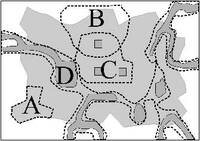- England
- Scotland
- France
- Holland
- Germany
- Italy
- Spain
- Portugal
- USA
- China
- Japan
- India
- Iran
- Advice
- Gardens
- England
- Scotland
- France
- Holland
- Germany
- Italy
- Spain
- Portugal
- USA
- China
- Japan
- India
- Iran
- Advice
- Garden Tours
Book: Landscape Planning and Environmental Impact Design: from EIA to EID
Chapter: Chapter 2 Landscape plans for public goods
Special area plans can be used for colour, historic character, construction materials, ethnic character, land use character and other matters. Municipalities can adopt plans to protect and enhance areas of special character, such as colour, building heights, construction materials and roof design. [Fig 2.17] Special areas should be defined for policy purposes: A. Pantile and whitewash zone. B. Zone of restricted building height (15m). C. Sandstone building zone. Greenway development zone. B. They work best in historic settlements, like fishing villages, which already have a high degree of unity, and in natural areas, like forests. But since people value unity, there is every reason to encourage coherence in new settlements. The Prince of Wales admires the use of rules, which he describes as 'an urban code' to give coherence to the town of Seaside in Florida (Charles, Prince of Wales, 1989). There is also a set of rules for his development at Poundberry outside Dorchester . Rural authorities can also adopt plans to protect and enhance special types of landscape quality, including wilderness and tranquility (Rendel, 1997). Where special area policies have not been approved, planning authorities should require designers to submit details of the planned relationship between new structures and their surroundings. The discipline of considering side-effects leads naturally to more sensitive design proposals. Three alternative relationships between development and surroundings are discussed in Chapter 3: Similarity, Identity or Difference (page..). In the small proportion of our towns which merit strict conservation measures, imitation will often be the best policy. If, for example, a gap appears in a fine Georgian terrace it is normally best to infill with a new Georgian building. Limpid attempts at imitating window or cornice lines are no substitute. In other places similarity or contrast will be appropriate ï¾ but the designer must know what he is doing and be able to define the intended relationship between a new building and its setting. Too many buildings are presented on design drawings which do not show the characteristics of the site or its surroundings. Towns need land mark s but confusion reigns if all buildings are designed to contrast with their neighbours. In some cases a total contrast can be very refreshing, as in the case of the Pompidou Centre in Paris . Partly, it succeeds because of difference from its surroundings.
